-
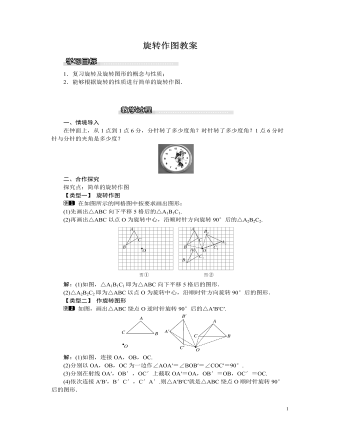
北师大初中八年级数学下册旋转作图教案
解析:整个阴影部分比较复杂和分散,像此类问题通常使用割补法来计算.连接BD、AC,由正方形的对称性可知,AC与BD必交于点O,正好把左下角的阴影部分分成(Ⅰ)与(Ⅱ)两部分(如图②),把阴影部分(Ⅰ)绕点O逆时针旋转90°至阴影部分①处,把阴影部分(Ⅱ)绕点O顺时针旋转90°至阴影部分②处,使整个阴影部分割补成半个正方形.解:如图②,把阴影部分(Ⅰ)绕点O逆时针旋转90°至阴影部分①处,把阴影部分(Ⅱ)绕点O顺时针旋转90°至阴影部分②处,使原阴影部分变为如图②的阴影部分,即正方形的一半,故阴影部分面积为12×10×10=50(cm2).方法总结:本题是利用旋转的特征:旋转前、后图形的形状和大小不变,把图形利用割补法补全为一个面积可以计算的规则图形.三、板书设计1.简单的旋转作图2.旋转图形的应用教学过程中,强调学生自主探索和合作交流,经历观察、归纳和动手操作,利用旋转的性质作图.
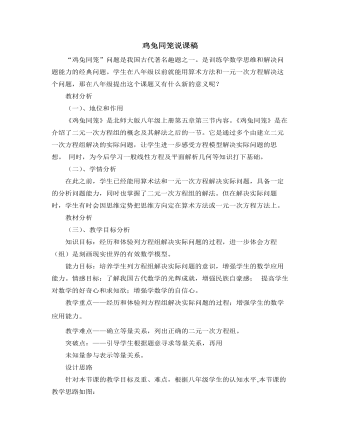
北师大版初中八年级数学上册鸡兔同笼说课稿
三、关于课本素材的处理课本素材:“鸡兔同笼”和“以绳测井”两个古代趣味问题。考虑到八年级学生独立思考和探索问题的能力都已达到一定的水平,特别增加了“自主探索,分层推进”这一环节,为每一位学生都提供了发展的空间。同时师生之间、学生之间共同研讨,形成教与学的和谐统一。凡能列二元一次方程组解决的问题,一般都可列一元一次方程来解,这就影响了用方程组去分析和解决问题,使学生形成思维定势。为此通过对“鸡兔同笼”多种求解方法的分析,使学生经历知识的发生过程,认识到列方程组的必要性和优越性,从而解决学生的思维定势的束缚。 以上是我对《鸡兔同笼》这一节课的一点思考,希望各位专家和老师指正,最后,我用布鲁克菲尔德的一句话来结束我的发言:让学生学会讨论、合作交流,讨论会使学生成为知识的共同创造者!
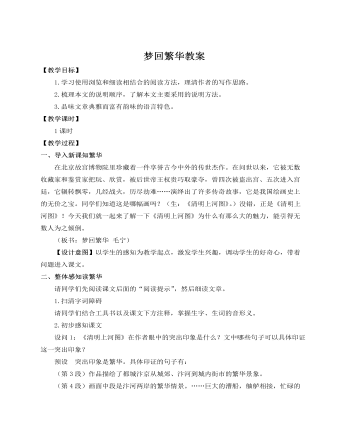
人教部编版语文八年级上册梦回繁华教案
设问2:第3段和第4段都写繁华,两段的区别是什么?预设 第3段是概括总写繁华景象,第4段则是具体描绘繁华景象。两段之间是从概括到具体的逻辑关系。【设计意图】通过细读课文,让学生在把握生字词的基础上对课文有初步的感知,可以用简单的词语概括作者所感知画面的整体特点,而且能够用文中具体的语句加以印证。以此训练学生自主把握文章重要信息的能力。三、自主探究寻繁华1.浏览课文,理清全文的说明顺序设问1:作者介绍了这幅画哪些方面的信息?在文中进行勾画批注,并说说文章可分为哪几个部分,概括主要意思。(生浏览勾画,批注交流)预设 文章分为三个部分:第1段:介绍这幅画作的创作背景,引出本文的说明对象——《清明上河图》。第2段:介绍了这幅画作的作者张择端及其创作动机。
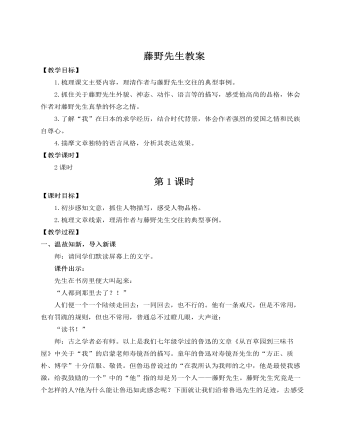
人教部编版语文八年级上册藤野先生教案
预设 清政府派遣这些留学生去国外留学,目的是学习国外先进的科学技术,回来报效国家,然而实际上他们在国外不学无术,忘记了自身使命和肩上的责任。作者在描写完留学生的这些丑态之后,采用了反语的手法,用一句话进行了总结——“实在标致极了”,仿佛是压抑不住的火山爆发,极尽讽刺之能事,酣发鄙夷、憎恶之胸臆。师:作者在这里采用了反语的手法,暗讽“清国留学生”们的丑态,除此之外,文中还有哪些地方运用了这种手法?预设 作者称日俄战争时的日本学生为“爱国青年”,说自己国内的论敌为“正人君子”,都是运用反语进行嘲讽。又如说日本对医学的翻译“并不比中国早”,说日本青年虽抗议托尔斯泰引用《新约》中的话,但他们“暗地里却早受了他的影响了”,都是话里有话,含义无穷的。【设计意图】此环节通过“咬文嚼字”,让学生学会从字里行间来品析文章深意,同时使学生进一步揣摩鲁迅先生“幽默讽刺、含蓄深蕴”的语言风格。
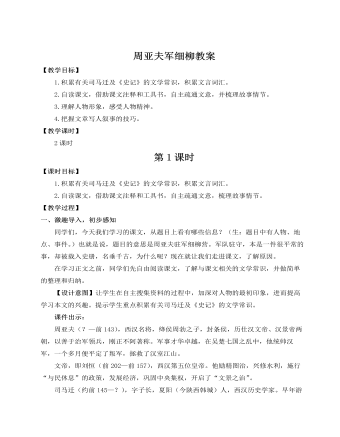
人教部编版语文八年级上册周亚夫军细柳教案
文帝之后六年,匈奴大入边。乃以宗正刘礼为将军,军霸上;祝兹侯徐厉为将军,军棘门;以河内守亚夫为将军,军细柳:以备胡。这一段主要围绕“大入边”之“大”来构建段落。整段文字看似与“大”无关,实则处处围绕“大”字做文章。写汉文帝三封将军“以备胡”,这是从内容上写胡人“入边”之“大”:边关吃紧,战势严峻。为了达到内容与形式的珠联璧合,司马迁在言语上连用三个“以……为……”的排比句式,以排山倒海的“声”势从言语上体现了“大”,以此增强文章的气势,形成一种“山雨欲来风满楼”的危急感。不仅如此,司马迁甚是在意言语细节。在连用三个“以……为……”时,打破言语的惯性,突然在第二个“以……为……”中省略了“以”字,这看似唐突,实则其心可鉴,省略第二个“以”字后,“以宗正刘礼为将军,军霸上;祝兹侯徐厉为将军,军棘门”不仅在视觉上间隔缩短,而且在朗读时彼此节奏加紧,联系更加紧密,军情更显危急,胡人“入边”之形势就显得更“大”了。而且,三个“以……为……”;“……为……”;“以……为……”之间张弛有度,一紧一松,营造了语势上的跌宕起伏,极具音韵之美。

人教部编版语文九年级上册任务三尝试创作(1)教案
例如《你是山间的清泉》《你是天空的雄鹰》《你是三春晖》《你是燃烧的红烛》等。先想好歌颂的对象,再展开联想、想象,结合事物的特点,融入自己的情感。如要写“母亲”,想想由母亲的特质可以联想到什么具体形象,如从母亲的勤劳想到老黄牛,从母亲对孩子无私的爱和付出联想到阳光、雨露、蜡烛等。 范文引路:五、课后巩固,布置作业(福建漳州)题目:守护 (将题目补充完整,然后作文)要求:(1)文体不限,字数不少于600字(诗歌不少于30行)。(2)不得出现真实人名、校名。(3)字迹工整,卷面整洁。 写作点拨:预设:本题是半命题作文题,题目“守护”是一个动词后面可以跟宾主,如“快乐”“向往”“妈妈”“歌声”等,或抽象或具体,都可以,还可以拟题“守护者”等。“守护”分为几个层面:谁守护?守护什么?怎样守护?守护结果如何?如此等等。可以抓住其中一个层面,写叙事诗、抒情诗、论辩色彩浓郁的诗等。从题目要求看,诗歌不少于30行,这么长的诗歌适合分为几个,通过几个片段、镜头、故事、感想等来表现主题。
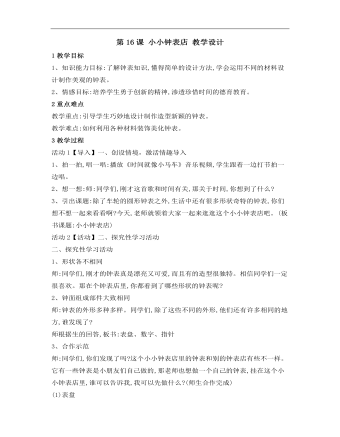
小学美术桂美版三年级上册《第16课小小钟表店1》教学设计说课稿
3教学过程活动1【导入】一、创设情境,激活情趣导入 1、拍一拍,唱一唱:播放《时间就像小马车》音乐视频,学生跟着一边打节拍一边唱。2、想一想:师:同学们,刚才这首歌和时间有关,那关于时间,你想到了什么?3、引出课题:除了车轮的圆形钟表之外,生活中还有很多形状奇特的钟表,你们想不想一起来看看啊?今天,老师就领着大家一起来逛逛这个小小钟表店吧。(板书课题:小小钟表店)

小学美术桂美版一年级上册《第1课美丽的大自然》教学设计说课稿
教学目标 知识目标:通过欣赏大自然的图片,感知大自然不同特点的美。 技能目标:能用自己喜欢的方式表达对不同自然美的感受。 情感态度与价值观:培养学生热爱大自然的情感,及爱护大自然的情感。 教学重点让学生感受大自然不同的美,了解大自然的丰富,并能用简单的语言表达自己的感受。 教学难点学习用审美的眼光去观察大自然。 主要教法启发引导法、自学尝试法 学习指导体验探究法辅助指导法 教学资源教师:教材、课件。 学生:教材、自然风光片 教学过程: 教学活动教学意图 教师学生
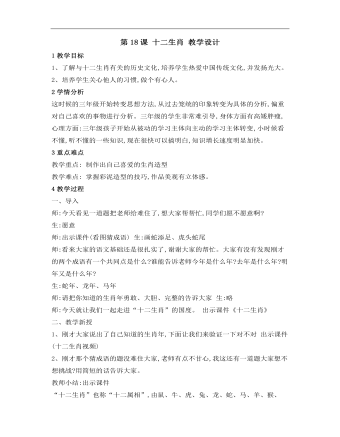
小学美术桂美版三年级上册《第18课十二生肖1》教学设计说课稿
一、导入师:今天看见一道题把老师给难住了,想大家帮帮忙,同学们愿不愿意啊?生:愿意师:出示课件(看图猜成语) 生:画蛇添足、虎头蛇尾师:看来大家的语文基础还是很扎实了,谢谢大家的帮忙。大家有没有发现刚才的两个成语有一个共同点是什么?谁能告诉老师今年是什么年?去年是什么年?明年又是什么年?生:蛇年、龙年、马年师:请把你知道的生肖年勇敢、大胆、完整的告诉大家 生:略师:今天就让我们一起走进“十二生肖”的国度。 出示课件《十二生肖》
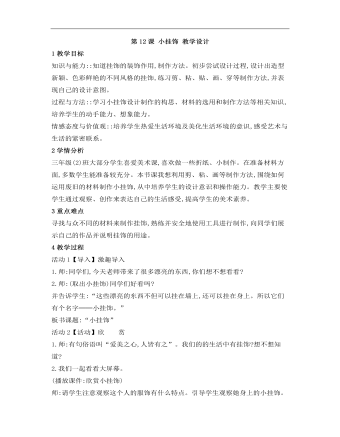
小学美术桂美版三年级上册《第12课小挂饰1》教学设计说课稿
2学情分析三年级(2)班大部分学生喜爱美术课,喜欢做一些折纸、小制作。在准备材料方面,多数学生能准备较充分。本节课我想利用剪、粘、画等制作方法,围绕如何运用废旧的材料制作小挂饰,从中培养学生的设计意识和操作能力。教学主要使学生通过观察、创作来表达自己的生活感受,提高学生的美术素养。3重点难点寻找与众不同的材料来制作挂饰,熟练并安全地使用工具进行制作,向同学们展示自己的作品并说明挂饰的用途。
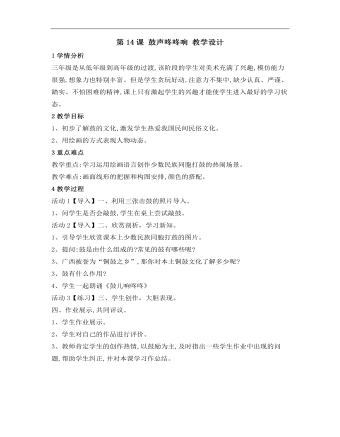
小学美术桂美版三年级上册《第14课鼓声咚咚响1》教学设计说课稿
2教学目标1、初步了解鼓的文化,激发学生热爱我国民间民俗文化。2、用绘画的方式表现人物动态。3重点难点教学重点:学习运用绘画语言创作少数民族同胞打鼓的热闹场景。教学难点:画面线形的把握和构图安排,颜色的搭配。

小学美术人教版三年级上册《第1课魔幻的颜色》教学设计说课稿
2学情分析1、学生学习美术的态度:很多学生上美术课时会抱着“玩”的心理,针对学生的这种思想,我们应当根据学生的年龄特点,在备课过程中注意挖掘教材中有趣的内容,寻找学生的兴趣点,充分地让美术教学体现出身心愉悦的活动特点,寓教于乐,防止把美术课变成一种枯燥的令人生厌的劳动。2、学生认知发展分析:在美术课堂上常常听到这样的声音:“我画(做)不好”、“我不会画(做)”;这就需要美术教师在课堂教学中注重引导学生感受、观察、体会、表现,让学生在一系列“玩中学”的活动过程中慢慢树立信心。所以围绕本课教学目的和任务,我采用情境教学法、观察对比法、直观演示法三种教学方式;学生运用四种方法进行学习:观察法、讨论法、实践体验法、合作交流法;努力营造一个开放和谐的课堂氛围,顺利完成教学目标。
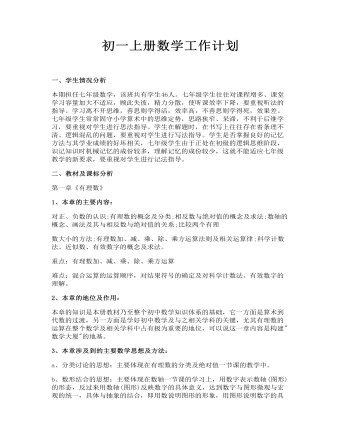
初一上册数学工作计划
第一章《有理数》1、本章的主要内容:对正、负数的认识;有理数的概念及分类;相反数与绝对值的概念及求法;数轴的概念、画法及其与相反数与绝对值的关系;比较两个有理数大小的方法;有理数加、减、乘、除、乘方运算法则及相关运算律;科学计数法、近似数、有效数字的概念及求法。重点:有理数加、减、乘、除、乘方运算难点:混合运算的运算顺序,对结果符号的确定及对科学计数法、有效数字的理解。

新人教版高中英语必修3Unit 1 Festivals and Celebrations-Reading and Thinking教学设计
The topic of this part is “Discover the reasons for festivals and celebrations.The Listening & Speaking & Talking part aims at talking about the experiences and feelings or emotions about the festivals and celebrations. This section aims at detecting the reason why the people celebrate the festivals, the time, the places, the types and the way of celebrations. It also explains why some traditions in the old celebrations are disappearing, like the firecrackers in the big cities and some new things are appearing like the prosperity of business or commerce. 1. Students can talk about what festivals they know and the reasons and the way of celebrating them.2. Students should learn the reading skills such as the headline and get the topic sentences, the structures of articles.3. Students can understand the past, the present situation of some festival around the world and why there are some changes about them. 4. Students can have the international awareness about the festivals.1. Students should learn the reading skills such as the headline and get the topic sentences, the structures of articles.2. Students can understand the past, the present situation of some festival around the world and why there are some changes about them.Step 1 Lead in---Small talkWhat festival do you like best ? Why ?I like the Spring Festivals because I can set off the fireworks, receive the lucky money and enjoy the Gala with my families.Step 2 Before reading---Pair workWhy do people celebrate different festivals ?The Spring Festivals is to celebrate the end of winter and the coming of spring and new life.The Mid-autumn Day is to celebrate the harvest and admire the moon.

新人教版高中英语必修3Unit 1 Festivals and Celebrations-Reading for writing教学设计二
Step 3 Analyzing article structureActivity 31. Teachers raise questions to guide students to analyze the chapter structure of this diary and think about how to describe the festival experience. (1)What should be included in the opening/body/closing paragraph(s)?(2)How did the writer arrange his/her ideas?(3)What kind of interesting details did the writer describe?(4)How did the writer describe his/her feelings/emotions during the event?2. Students read and compare the three sentence patterns in activity 2. Try to rewrite the first paragraph of the diary with these three sentence patterns. After that, students exchange corrections with their partners. Such as:●This was my first time spending three days experiencing the Naadam Festival in China’s Inner Mongolia Autonomous Region and it was an enjoyable and exciting experience. ●I'll never forget my experience at the Naadam Festival because it was my first time to watch the exciting Mongolian games of horse racing, wrestling, and archery so closely. ●I'll always remember my first experience at the Naadam Festival in China’s Inner Mongolia Autonomous Region because it was so amazing to spend three days witnessing a grand Mongolian ceremony. Step 4 Accumulation of statementsActivity 41. Ask the students to read the diary again. Look for sentences that express feelings and emotions, especially those with the -ing form and the past participle. Such as:● …horse racing, wrestling, and archery, which are all so exciting to watch. ● some amazing performances● I was surprised to see…● I was a little worried about. . . ● feeling really tiredOther emotional statements:●I absolutely enjoyed the archery, too, but the horse races were my favourite part. ●I'm finally back home now, feeling really tired, but celebrating Naadam with my friend was totally worth it. ●He invited me back for the winter to stay in a traditional Mongolian tent and cat hot pot. I can’t wait!2. In addition to the use of the -ing form and the past participle, the teacher should guide the students in the appreciation of these statements, ask them to memorize them, and encourage them to use them reasonably in writing practice.
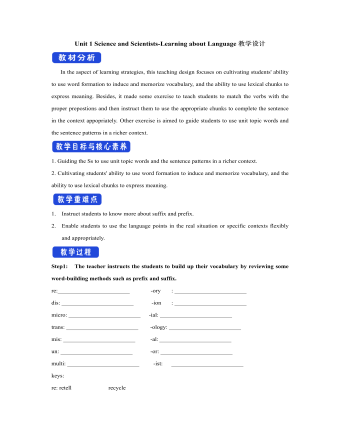
新人教版高中英语选修2Unit 1 Science and Scientists-Learning about Language教学设计
Step 7: complete the discourse according to the grammar rules.Cholera used to be one of the most 1.__________ (fear) diseases in the world. In the early 19th century, _2_________ an outbreak of cholera hit Europe, millions of people died. But neither its cause, 3__________ its cure was understood. A British doctor, John Snow, wanted to solve the problem and he knew that cholera would not be controlled _4_________ its cause was found. In general, there were two contradictory theories 5 __________ explained how cholera spread. The first suggested that bad air caused the disease. The second was that cholera was caused by an _6_________(infect) from germs in food or water. John Snow thought that the second theory was correct but he needed proof. So when another outbreak of cholera hit London in 1854, he began to investigate. Later, with all the evidence he _7_________ (gather), John Snow was able to announce that the pump water carried cholera germs. Therefore, he had the handle of the pump _8_________ (remove) so that it couldn't be used. Through his intervention,the disease was stopped in its tracks. What is more, John Snow found that some companies sold water from the River Thames that __9__________________ (pollute) by raw waste. The people who drank this water were much more likely _10_________ (get) cholera than those who drank pure or boiled water. Through John Snow's efforts, the _11_________ (threaten) of cholera around the world saw a substantial increase. Keys: 1.feared 2.when 3. nor 4.unless 5.that/which 6.infection 7.had gathered 8.removed 9.was polluted 10.to get 11. threat
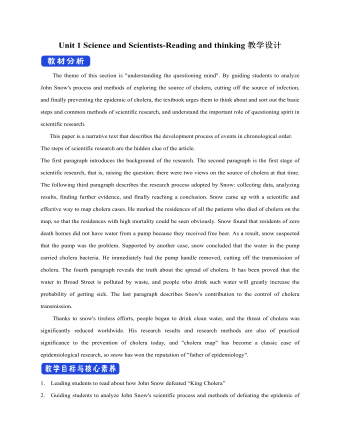
新人教版高中英语选修2Unit 1 Science and Scientists-Reading and thinking教学设计
Step 5: After learning the text, discuss with your peers about the following questions:1.John Snow believed Idea 2 was right. How did he finally prove it?2. Do you think John Snow would have solved this problem without the map?3. Cholera is a 19th century disease. What disease do you think is similar to cholera today?SARS and Covid-19 because they are both deadly and fatally infectious, have an unknown cause and need serious public health care to solve them urgently.keys:1. John Snow finally proved his idea because he found an outbreak that was clearly related to cholera, collected information and was able to tie cases outside the area to the polluted water.2. No. The map helped John Snow organize his ideas. He was able to identify those households that had had many deaths and check their water-drinking habits. He identified those houses that had had no deaths and surveyed their drinking habits. The evidence clearly pointed to the polluted water being the cause.3. SARS and Covid-19 because they are both deadly and fatally infectious, have an unknown cause and need serious public health care to solve them urgently.Step 6: Consolidate what you have learned by filling in the blanks:John Snow was a well-known _1___ in London in the _2__ century. He wanted to find the _3_____ of cholera in order to help people ___4_____ it. In 1854 when a cholera __5__ London, he began to gather information. He ___6__ on a map ___7___ all the dead people had lived and he found that many people who had ___8____ (drink) the dirty water from the __9____ died. So he decided that the polluted water ___10____ cholera. He suggested that the ___11__ of all water supplies should be _12______ and new methods of dealing with ____13___ water be found. Finally, “King Cholera” was __14_____.Keys: 1. doctor 2. 19th 3.cause 4.infected with 5.hit 6.marked 7.where 8.drunk 9.pump 10.carried 11.source 12.examined 13.polluted 14.defeatedHomework: Retell the text after class and preview its language points
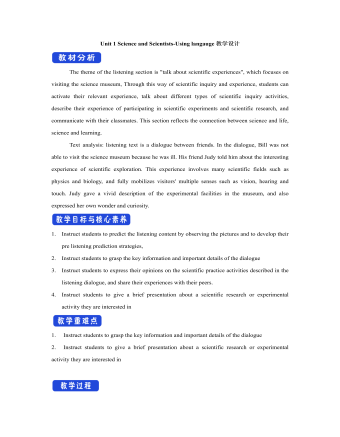
新人教版高中英语选修2Unit 1 Science and Scientists-Using langauge教学设计
This happens because the dish soap molecules have a strong negative charge, and the milk molecules have a strong positive charge. Like magnets, these molecules are attracted to each other, and so they appear to move around on the plate, taking the food coloring with them, making it look like the colors are quickly moving to escape from the soap.Listening text:? Judy: Oh, I'm so sorry that you were ill and couldn't come with us on our field trip. How are you feeling now? Better?? Bill: Much better, thanks. But how was it?? Judy: Wonderful! I especially liked an area of the museum called Light Games.it was really cool. They had a hall of mirrors where I could see myself reflected thousands of times!? Bill: A hall of mirrors can be a lot of fun. What else did they have?? Judy: Well, they had an experiment where we looked at a blue screen for a while, and then suddenly we could see tiny bright lights moving around on it. You'll never guess what those bright lights were!? Bill: Come on, tell me!? Judy: They were our own blood cells. For some reason, our eyes play tricks on us when we look at a blue screen, and we can see our own blood cells moving around like little lights! But there was another thing I liked better. I stood in front of a white light, and it cast different shadows of me in every color of the rainbow!? Bill: Oh, I wish I had been there. Tell me more!? Judy: Well, they had another area for sound. They had a giant piano keyboard that you could use your feet to play. But then, instead of playing the sounds of a piano, it played the voices of classical singers! Then they had a giant dish, and when you spoke into it, it reflected the sound back and made it louder. You could use it to speak in a whisper to someone 17 meters away.? Bill: It all sounds so cool. I wish I could have gone with you? Judy: I know, but we can go together this weekend. I'd love to go there again!? Bill: That sounds like a great idea!
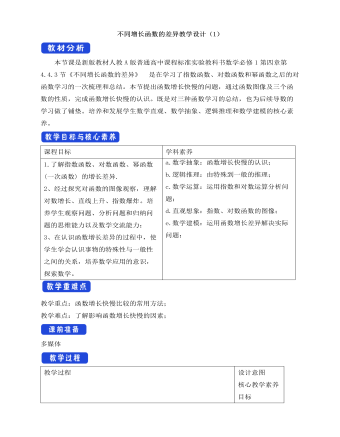
人教A版高中数学必修一不同增长函数的差异教学设计(1)
本节课是新版教材人教A版普通高中课程标准实验教科书数学必修1第四章第4.4.3节《不同增长函数的差异》 是在学习了指数函数、对数函数和幂函数之后的对函数学习的一次梳理和总结。本节提出函数增长快慢的问题,通过函数图像及三个函数的性质,完成函数增长快慢的认识。既是对三种函数学习的总结,也为后续导数的学习做了铺垫。培养和发展学生数学直观、数学抽象、逻辑推理和数学建模的核心素养。1.了解指数函数、对数函数、幂函数 (一次函数) 的增长差异.2、经过探究对函数的图像观察,理解对数增长、直线上升、指数爆炸。培养学生观察问题、分析问题和归纳问题的思维能力以及数学交流能力;3、在认识函数增长差异的过程中,使学生学会认识事物的特殊性与一般性之间的关系,培养数学应用的意识,探索数学。 a.数学抽象:函数增长快慢的认识;b.逻辑推理:由特殊到一般的推理;
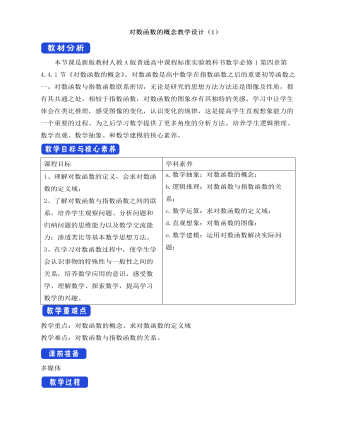
人教A版高中数学必修一对数函数的概念教学设计(1)
本节课是新版教材人教A版普通高中课程标准实验教科书数学必修1第四章第4.4.1节《对数函数的概念》。对数函数是高中数学在指数函数之后的重要初等函数之一。对数函数与指数函数联系密切,无论是研究的思想方法方法还是图像及性质,都有其共通之处。相较于指数函数,对数函数的图象亦有其独特的美感。学习中让学生体会在类比推理,感受图像的变化,认识变化的规律,这是提高学生直观想象能力的一个重要的过程。为之后学习数学提供了更多角度的分析方法。培养学生逻辑推理、数学直观、数学抽象、和数学建模的核心素养。1、理解对数函数的定义,会求对数函数的定义域;2、了解对数函数与指数函数之间的联系,培养学生观察问题、分析问题和归纳问题的思维能力以及数学交流能力;渗透类比等基本数学思想方法。3、在学习对数函数过程中,使学生学会认识事物的特殊性与一般性之间的关系,培养数学应用的意识,感受数学、理解数学、探索数学,提高学习数学的兴趣。





